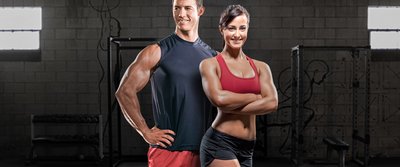Back | Main | Next

You may have noticed that even though we're now heading into the fifth day of your new program, we left out an important detail. We haven't told you exactly how to schedule your meals. Other than eating protein and veggies, you don't know much.
After yesterday's lesson, you have a better idea of what foods to buy, but now comes the time to bring it all together.
We waited a few days for simplicity, but also so you didn't become confused by all the different "perfect diets" that exist. To understand why it's so hard to get a pulse on the best route, you need to look back about 30 years.
That's when dietary fat became the evil of all evils. Scientists blamed fat consumption for everything from obesity to why the Cubs can't win the World Series.
In order to rid the world of obesity, heart problems, and cardiovascular disorders, the food industry went cold turkey from fat. In came new food creations: fat-free cheese, fat-free ice cream, and fat-free cookies. Red meat and its saturated fat were blackballed, and the carb generation took over.
It was almost too simple. If there's no fat then it must be healthy, right?
There was one small problem. As people ate less and less fat, they generally became fatter and fatter. Obesity rates began climbing to an all-time high.
Part of the problem was the fat-free movement gave birth to the sugar revolution. Rather than flavor foods with fat, everything became loaded with sweeteners. The result was a pre-diabetic nation that was sabotaged with every bite it took.
We weren't eating enough fat. Your diet should consist of anywhere between 20-35 percent fat. Fat keeps you full! It's been linked to a faster metabolism, lower rates of heart diseases, higher testosterone, more muscle, a healthier brain, stronger bones, and a better immune system. If that's not enough to convince you, well, that's OK. Diets higher in fat also are linked to improved cardiovascular risk factors, and healthier lungs and liver. Your body needs fat to function.
While many still fear fat, the trepidation has gradually shifted from fat to the new dietary enemy du jour—carbs. For the past 20 years, the low-carb movement has made bread and pasta the most unwanted foods on any fat-loss plan. While lower carb plans are undoubtedly healthy, cutting all carbs out of your life is not necessary. If you're trying to gain muscle, eating carbs is a required part of the plan.
So where does that leave you? Dazed? Confused? Wanting to eat donuts?
The amount of misinformation makes it hard to plan your meals. We're here to help! Determining what to eat, when to eat, and how much to eat doesn't need to be so damn difficult. There are many diets that work and many more that don't. The real difference is your decision-making. Set up a plan that's simple to follow and not a burden to maintain.
Meal Manager

{{caption}}
Include two basic elements in every meal: protein and vegetables. We've made that necessary homework since the second day. Moving forward, we want you to approach how you eat based on your level of activity.
On days you lift weights, eat more carbs. On days you don't work out, eat fewer carbs. Everything else stays similar. Still eat a lot of protein. Vegetables will be a necessity. Do not avoid fats.
On workout days
- Eat protein and vegetables at each meal.
- Before your workout, take in a small amount of carbohydrates, such as half a cup of rice, a piece of fruit, or a bowl of oatmeal.
- After your workout, have a meal of protein, vegetables, and either fruit or a non-processed carbohydrate source, such as potatoes or rice.
- At meals where you don't eat carbs (with the exception of vegetables), eat a combination of protein and fat.

Rice is good for pre-workout carbs, and potatoes are a good choice for post-workout carbs.
On non-workout days
- Eat protein and vegetables at each meal.
- Try to limit starchy forms of carbs; instead eat a few pieces of fruit for the day.
- Make sure your fat intake is high enough; enjoy foods such as eggs, fatty fish, (salmon), and avocado, or have snacks such as almonds or different nut butters.
How many times should you eat per day?
You tell me. No seriously. That choice is up to you. Researchers from Canada compared the role of meal frequency on fat loss, muscle gain, and satiety (how hungry you feel).

{{caption}}
They found something surprising to most people—how many times you eat per day does not matter. As long as you eat the right foods and the right amounts, you can get in great shape.
I know what you might be thinking? Doesn't eating more frequently stoke your metabolism? Well, not really. Your metabolism is affected more by what you eat than how frequently you eat. You are in control of your daily menu.
If you like eating big meals and don't like grazing on smaller portions, feel free to eat the traditional three square meals per day. If you like eating more frequently, then have your three meals and add in 1-3 snacks per day.
Be careful about portion sizes. If it's bigger than what fits in the palm of your hand, it's guaranteed to make your belly bigger.
Does it matter when you eat?
Whether you eat at 5 a.m. or 10 p.m., the same fundamental principles apply. Focus on what you eat and the amount, and you'll be fine.
Hollywood actors are notorious for attributing their six-pack abs to eating by the clock; they cut out carbs—or even all foods—after 7 or 8 p.m. That's great if it works for them, but there's nothing that says eating later at night will turn you into a fatass. It just doesn't work that way.
If you know you are susceptible to late-night binges, maybe it's in your best interest to curb late-night eating. The best plans are both flexible and sustainable.
Eating late at night won't make you fat. Israeli researchers found that dieters who ate the majority of their calories in the late evening actually lost more fat and had fewer hunger cravings.
It all comes back to following the simple rules. Eat protein and veggies.
Mix in carbs—from grains, rice, fruit, or veggies—before and after your workouts, and don't be afraid of eating fats from meat, dairy, nuts, and oils. As long as your meals are in check, you'll never have to worry about eating at the wrong time.
What about supplements?
When you first start a new program, it's best to handle your supplement protocol like everything else—keep it simple. It's easy to get excited about all the possibilities, and wonder what a little extra help might do for your body. Here's what you need to know about supplements: They exist to fill gaps in your fitness plan.
Diet and workouts will always provide the most staggering results. Supplements make sure you don't have any weaknesses in your approach. As you become more familiar with your body and your needs, you should consider other options, such as pre-workout products and proven performance-enhancers, such as creatine.
we suggest three supplements
- Protein Powder: You need protein in your diet. Sometimes your budget—or your schedule—makes it tough to eat all the chicken and steak your body requires. This is the efficient and cost-effective way to make sure you don't fall short of your protein goals.
- Fish Oil: This supplement offers all-in-one magic. It improves heart health, lowers triglycerides, helps you recover from tough exercise sessions, and maintains good brain health.
- Multivitamin: This is the staple of a supplement protocol. Your improved diet will undoubtedly be packed full of the nutrients your body wants, but the multivitamin makes sure your body has everything it needs. Think of it as a dietary insurance policy.

Recommended supplements include, protein powder, fish oil, and multivitamins.
Your daily checklist
Reminder: You should complete Workout B today after taking yesterday off. For a reminder about what you should be doing, click here.
1. Write down your goals
2. Sleep 7-8 hours
3. Drink at least 6 glasses of water
4. Include protein in each of your meals
5. Eat veggies at every meal.
6. Track your fitness and diet
7. Go for a 20-minute walk
8. Avoid crap foods
9. Foam roll
If you never heard of foam rolling, it's about time you become familiar. This form of self massage is an effective technique that can be applied before or after a workout, or on your off days. All you need is a foam roller or PVC pipe, and then your roll on a few key areas—your hips, glutes, quads, hamstrings, back, and chest.
Just 5-10 minutes of your time can improve the way you move. It reduces tension in your body, provides you with better flexibility/mobility, helps reduce muscle soreness, and potentially helps you lift more weight. I'll warn you: It's not a comfortable process. But, when you're done, your body feels much better for the work you put it. For a quick foam rolling tutorial, check this out.
10. Make a protein shake
For many people, making protein shakes is a rite of passage into the world of the fit. There's nothing magical about protein powders. Enjoying these drinks won't suddenly turn you into a mass monster. Research is favorable for those who choose to make protein shakes a part of their routine.
Protein powder is low in calories, high in protein, and is tied to positive research on muscle growth. Dieters who make a whey shake each day doubled their fat loss compared to those who ate the same amount of calories, but didn't down any powder, according to research in The Journal of Nutrition.
Step 1: Pick a liquid—I suggest almond milk or water. Add 8 oz.
Step 2: Add ice cubes—4-6 should do the trick
Step 3: Add protein powder—1-2 scoops of the flavor of your choice
Step 4: Add a fat—A small handful of nuts or 1 scoop of your favorite almond butter
Step 5: Add a fruit—Bananas, strawberries, and blueberries all make good options. To make it taste even better, freeze the fruit. It makes a big difference.
Step 6: Add greens—Yep, add spinach or kale. Don't worry, you won't taste it, but your body will feel it.
Step 7: Blend and enjoy!

